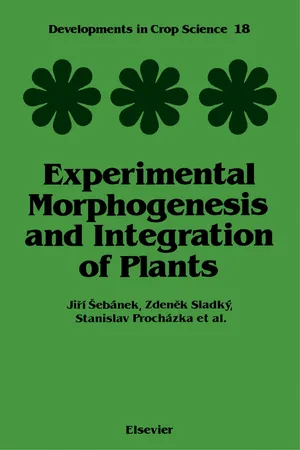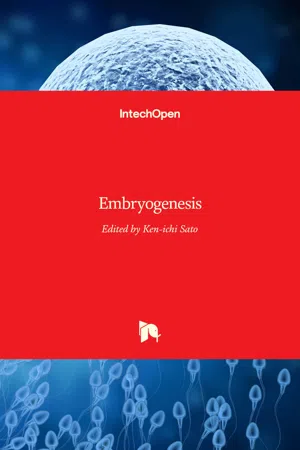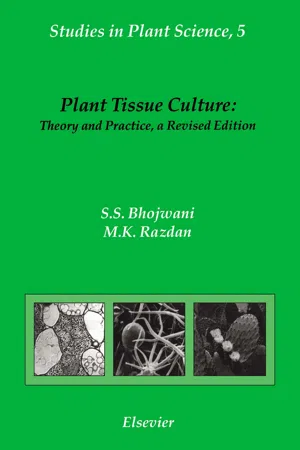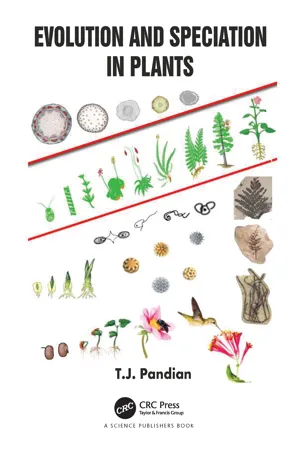Biological Sciences
Double Fertilization
Double fertilization is a unique process in flowering plants where two sperm cells fertilize two different cells within the ovule. One sperm cell fertilizes the egg cell to form the embryo, while the other sperm cell combines with two polar nuclei to form the endosperm, which provides nourishment to the developing embryo. This process is a defining characteristic of angiosperms.
Written by Perlego with AI-assistance
Related key terms
1 of 5
9 Key excerpts on "Double Fertilization"
- J. Sebanek, M. Kutacek, M. Luxova, O. Erdelska, Z. Sladky, S. Prochazka(Authors)
- 2012(Publication Date)
- Elsevier Science(Publisher)
4 EXPERIMENTAL MORPHOGENESIS OF SEEDS AND FRUITS 4.1 Double Fertilization of angiosperms In flowers, both the male and female reproductive organs, i.e. stamens and gynoecium, develop. In the anthers of the stamens pollen grains develop during microsporogenesis. In them, the male sexual cells, the male gametes, develop with a reduced number of chromosomes. The gynoecium usually consists of a stigma, style and ovary in which one or several ovules develop. During the process of megasporogenesis and megagametogenesis, which usually take place before anthesis, the embryo sac develops in the ovule of angiosperms and in it the female sexual cell with a reduced number of chromosomes. In the process of fertilization, the male and female gametes fuse into one cell, the zygote, from which the embryo develops. Before fusion of the sexual cells, the pollen grain is transferred by insects, wind, or other vectors, to the stigma where it germinates. The pollen tube then grows through the stigma and style, into the ovary, and to the ovule. During the growth of pollen tubes, specific compatible or incompatible reactions occur which operate a selection of pollen tubes in their growth to the embryo sac. In the embryo sac Double Fertilization occurs when one of the two male gametes released from the pollen tube fuses with the egg cell and the other with the central cell of the embryo sac. From the fertilized egg cell a zygote develops, and from the fertilized central cell a primary endosperm cell. Double Fertilization is characteristic of, and only occurs in, angiosperms. In gymnosperms, fertilization is only simple. Simple fertilization in angiosperms is rare. The course and importance of Double Fertilization of angiosperms has been studied from different aspects using different methods (optic and electron micro-scopy, cytochemistry, etc.) since its discovery in the late 19th century. This problem has been the subject of special studies on genetics and embryology.- eBook - PDF
Mate Choice in Plants
Tactics, Mechanisms, and Consequences
- Nancy Burley, Mary F. Willson(Authors)
- 2020(Publication Date)
- Princeton University Press(Publisher)
The addition of nongametic material would benefit the mother (Table 4, cols. 4 and 7), and mechanistically this transformation could be made if following the first reduc-tion division of meiosis all products were saved. On the other hand, the loss of the gametic complement would not be beneficial to the mother (Table 4, compare cols. 3 and 4, 6 and 7). If the tetrasporic condition did not evolve in this fashion, it is not clear in which order the addition and loss occurred (Figure 5C). In sum, the origin of Double Fertilization may have arisen through kin selection involving parent-offspring conflict or through male-female conflict. We feel that parent-off-spring conflict is less likely, for reasons discussed earlier (Chapter 1) and because the selection pressures acting to produce Double Fertilization must have concentrated on males. Within the framework of argument based on de-grees of relatedness, subsequent increases in ploidy are most likely the result of male-female conflict expressed through conflict operating at the level of the gene. We have found no evidence that the male nucleus multiplies before joining the female polar nuclei, but if such a case were ever found, it would be most interesting in the possible impli-cation for endosperm evolution. Occasionally, the egg nucleus is fertilized by sperm from one pollen grain and the polar nuclei by sperm from an-other (Brink and Cooper, 1947). Effectively, one male might be parasitizing another by using the materials in the other's pollen to enhance the growth of his embryo. The partial or complete elimination of endosperm and hence of functional Double Fertilization in certain angio-sperms (e.g., Podostemaceae and most Orchidaceae: see Brink and Cooper, 1940; Poddubmayer-Arnoldi, 1960; 87 COMPETITION AND CHOICE Davies, 1966) precludes these possibilities. Mycorrhizal nu-trition coupled with the production of numerous miniscule seeds in orchids may have selected for reduction of en-dosperm. - Caula A. Beyl, Robert N. Trigiano, Caula A. Beyl, Robert N. Trigiano(Authors)
- 2016(Publication Date)
- CRC Press(Publisher)
• Mutation breeding and biotechnology can be used to breed new cultivars from clonal material without sexual reproduction. 66 Timothy A. Rinehart, Robert N. Trigiano, Phillip A. Wadl, and Haley S. Smith thousands upon thousands of exact genetic copies of ‘Cherokee Sunset.’ In the end, the consumer receives the desired product with the expected characteristics. Other horticultural plants, especially many bedding species and vegetable crops, are propagated mainly by seeds. This is a sexual process that entails meiosis in both the male and the female cells to form haploid gametes. The original diploid number of the chromosome is restored by the fusion of the haploid gametes from each parent. As will be discussed below in more detail, sexual reproduction in angiosperms involves pollination, in which the pollen or the male gametophyte lands on receptive female sur-faces, usually the stigma of the ovary. Eventually, a pro-cess called “Double Fertilization” takes place, in which one male sperm nucleus fuses with the female egg to create the zygote and another sperm nucleus fuses with two other nuclei of the female gametophyte to form the primary endosperm nucleus. The result of sexual reproduction is a seed containing an embryo and everything necessary to grow a new seedling. ALTERNATION OF GENERATIONS The concept of alternation of generations is central to understanding sexual reproduction in angiosperms as well as most other organisms. In this case, generations do not refer to parents and children, but rather to the nuclear condition or the ploidy number of the plant’s cells during the life cycle of the plant. Ploidy level is the number of copies of chromosomes in the nucleus.- eBook - PDF
- Ken-ichi Sato(Author)
- 2012(Publication Date)
- IntechOpen(Publisher)
Then the spermatic cells are discharged into one of the synergids through the filiform apparatus (Yadegari & Drews, 2004). Double Fertilization takes place when one spermatic nucleus fuses with the egg cell forming the zygote (diploid), while the second sperm fuses with the polar nuclei of the central cell to initiate the endosperm (generally triploid) (Russell, 1993). The observed polarity of zygotic embryos starts with the formation of the embryo sac. This polarity in the embryo sac is due to a gradient of the natural auxin indole-acetic acid along the micropyle-chalaza axis whose expression starts at the micropylar region outside of the embryo sac. In the same manner and following this pattern, the haploid egg cell which after its fertilization produces the embryo, is also highly polarized with its nucleus located at the chalazal pole (Pagnussat et al., 2009). Pagnussat et al. (2009) reported that it is possible that auxin does not regulate the position of the nuclei during the embryo sac formation, however it participates in the regulation of cell fate at cellularization. After fertilization, the resulting diploid zygote remains highly polarized, while the other male gamete fuses with the central cell of the embryo sac which then develops into the triploid endosperm, acting as a nutritive and protective element for the embryo. In the majority of the plant species, the somatic embryogenesis process follows the above pattern. In the case of somatic embryogenesis being the initial somatic embryogenic cell equivalent to the zygote, and the in vitro culture medium being equivalent to the nutritive and protective endosperm (Figure 3). Embryogenesis 232 In angiosperms, the first division of the zygote is highly asymmetric. Actin governs the migration of the premitotic nucleus into the future division plane and the placement of the preprophase band in these asymmetrically dividing cells (Rasmussen et al., 2011). - eBook - PDF
- T B Batygina(Author)
- 2005(Publication Date)
- CRC Press(Publisher)
Modilewsky (1958) was of same opinion considering that the cytological aspect of the Double Fertilization in angiosperms was scarcely developed. Use of the method of temporal fixation of the material facilitated progress in study of the cytology and cytochemistry of this process (Gerassimova-Navashina, 1947a,b, 1986; Batygina, 1957, 1959, 1961a,b, 1962a,b, 1966, 1974b; Poddubnaya- Amoldi, 1958, 1976; Korobova, 1959, 1962; Savina, 1964, 1965; Yakovlev and Yoffe, 1965; Chebotaru, 1972, 1987; Bannikova and Khvedynich, 1982). Ultrastructural investigations have also contributed their share to understanding syngamic mechanisms (Vazart, 1955; Jensen, 1964a,b, 1973; Gerassimova-Navashina and Gulyaev, 1973; Cass, 1973, 1981; Russell, 1983, 1985a,b; You and Jensen, 1985; Mogensen and Rusche, 1985; Van Lammeren, 1986a,b; Cresti et al., 1988a; Zhukova, 1993; Plyushch, 1992; Faure et al., 1993; Kranz and Lorz, 1993, 1994; Kranz et at., 1995). However, our notion about this process remains incomplete to date. One reason lies in the methodological complexity of obtaining a number of ultrathin slices and computer-based reconstruction of syngamy due to the transiency of some of its stages. The other reason is lack of a system comparative study of cytoembryological processes in vivo and in vitro at light and ultrastructural levels. Choice of an object is of no small importance. Before examining the process of union of the sperm and the egg cell we shall briefly recall some peculiarities of the structure of the egg apparatus which have a direct relation to the mechanism of syngamy. Egg apparatus. Revelation of considerable differences in the structure of the egg apparatus in various species of flowering plants has initiated use of the terms 'distinctly differentiated', 'poorly differentiated' and 'undifferentiated' egg apparatus (Plyushch, 1992). Such features as the size, polarity and topography of its elements are considered. - eBook - PDF
- S.S. Bhojwani, M.K. Razdan(Authors)
- 1996(Publication Date)
- Elsevier Science(Publisher)
269 Chapter 10 In Vitro Pollination And Fertilization 10.1. INTRODUCTION Sexual hybridization is a powerful tool in the hands of plant breeders for producing superior plants by combining characters distributed in dif- ferent members of a species or different species of a genus. The technique involves controlled, artificial pollination of the female parent with pollen from the selected male parent. In angiosperms the female gametophyte, enclosing the egg (female gamete), is deep-seated in the ovarian cavity, well protected by the ovular tissues. The pollen grains are normally held at the stigma and there is no device for them to reach the egg. To effect fertilization the pollen grains germinate on the stigma by putting forth a tube (pollen tube) which grows through the stigma and style, finds its way into the ovule and discharges two sperms in the vicinity of the egg. One of them fuses with the egg, forming a zygote (the progenitor of the embryo), while the other fuses with the polar nuclei forming the primary endosperm nucleus. In nature, a stigma receives a variety of pollen grains, but not all those that reach the stigma succeed in effecting fertilization. The stigma and style are equipped with devices to allow pollen of only the right mating type to function normally; others are discarded. Consequently, in hy- bridization programmes transferring viable pollen from one parent to the receptive stigma of another does not always lead to seed-set. Some of the barriers to fertilization are: (a) inability of pollen to germinate on foreign stigma; (b) failure of the pollen tube to reach the ovule due to excessive length of the style, or slow growth of the pollen tube, so that ovary ab- scises before the pollen tube reaches the base of the style; and (c) burst- ing of the pollen tube in the style. These are pre-fertilization or pre- zygotic barriers. - eBook - PDF
Flowering Plant Embryology
With Emphasis on Economic Species
- Nels R. Lersten(Author)
- 2008(Publication Date)
- Wiley-Blackwell(Publisher)
From barley as in Fig. 8.19A–E but showing progressive movement of one sperm from egg cell into egg nucleus (A–G), merger of nuclei (H), and prophase of first mitosis in zygote. From Luxová (1967). Chapter 8: Pollen Germination and Double Fertilization 145 sperm cells, which is scanty and therefore dif-ficult to identify. The question of whether sperm cell cytoplasm, and particularly any mitochondria or plastids, is carried into the egg cell has long been debated. Sperm cell plastids of some plants have been reported to enter the egg cell and to persist, mingled with maternal plastids, up to the globe stage of the embryo, but there is no report of such biparental inheri-tance of plastids extending beyond the globe stage (see Chapter 6 for discussion of sperm plastids). The diagram in Figure 8.22 was reconstruct-ed by Mogensen (1988) from electron micro-scope sections of a barley embryo sac, which allows a closer look at fertilization than Luxová C A B D G H I E F Figure 8.21A–I. From barley as in Fig. 8.20A–I, but showing progressive fusion of second sperm cell with the two polar nuclei (pn). From Luxová (1967). 146 Flowering Plant Embryology could provide with her light microscope study. It shows that the cytoplasm of one of the sperm cells is left behind in the degenerating synergid while its nucleus continues on into the egg cell. Mogensen suggested alternatively that perhaps the “cytoplasmic body” represents the fused cytoplasm of both sperm cells, since he could find no evidence of the fate of the cytoplasm of the second sperm nucleus on its way to the cen-tral cell nuclei. The male germ unit and dimorphic sperms were described earlier in this chapter, and they must now be reconsidered with respect to fertil-ization. Until recently it was assumed that the two sperm cells were identical, each having an equal chance of merging with egg nucleus or central cell nuclei. - eBook - PDF
- Phatlane William Mokwala(Author)
- 2018(Publication Date)
- IntechOpen(Publisher)
Using a novel in vivo assay, Mori et al . demonstrated the requirement of GEX2 for gamete attachment, as Double Fertilization is compromised in its absence. 5. Fertilization recovery system In angiosperms, Double Fertilization within the ovule occurs with the entry of two sperm cells, which are usually delivered by a single pollen tube. In 1904, Wylie [ 32 ] observed the insertion of two pollen tubes in an Elodea canadensis ovule and concluded, “It often happens that two pollen tubes pass into one ovule; in such cases both synergids disappear.” Since this discov -ery, the reception of two pollen tubes in an embryo sac, although rare, has been reported in at least 12 species [ 33 ]. Similarly, the reception of two pollen tubes has been reported in several Arabidopsis mutants, including the gcs1 mutant [ 30 ]. Although this phenomenon is interest -Figure 5. Discharge of sperm cells from the pollen tube tip to Double Fertilization. (A) Upon reaching an ovule, the pollen tube grows along the surface of the ovule’s funiculus, through the micropyle, and into the female gametophyte. The pollen tube enters the female gametophyte by growing through the synergid cells. The pollen tube then comes in contact with the synergid cells and ceases growth. One of the synergid cells then undergoes cell death. Finally, soon after synergid degeneration is initiated, the pollen tube ruptures and releases two sperm cells into the degenerating synergid cytoplasm. The two sperm cells then move toward and fuse with the egg cell and central cell to complete Double Fertilization. (B) The male gametes of gcs1 mutant fail to fuse with the egg or central cell. GCS1 accumulates during late gametogenesis and localizes on the plasma membranes of generative cells. The male gametes of gex2 mutant also fail to fuse with the egg or central cell but the frequency of failure is lower than the gcs1 mutant. - eBook - ePub
- T.J. Pandian(Author)
- 2022(Publication Date)
- CRC Press(Publisher)
Part C Gametogenesis and FertilizationGametogenesis is the process through which gametes are produced. Unlike in animals, gametes are generated through mitosis in haplontic algae and bryophytes. However, they are produced through meiosis and also at the ratio of one egg per oogonium but four sperms or pollens per spermatogonium in all pteridophytes, as in animals. Angiosperms are characterized by Double Fertilization. In lower plants including bryophytes and tracheophytes, oogamous fertilization is achieved by motile spermatozoa swimming through anaqueous medium. But it is achieved symbiotically engaging pollinating animals in most flowering plants. Interestingly, pollination involves coevolution between pollinators and plants. Spores and seeds of plants are dispersed by water, and wind as well as symbiotically engaging animals.Passage contains an image
10 Oogenesis and Spermatogenesis
Introduction
Regarding gametogenesis, animals and plants present a contrasting picture. Firstly, gametogenesis in animals and plants pass through constrasting sequences. The haplontic algae and bryophytes commence with a ‘wrong’ sequence of fertilization preceding meiosis. However, diplontic plants have stabilized to the ‘right’ sequence of meiosis preceding fertilization; in angiosperms, the final event is, however, complicated by Double Fertilization. Not surprisingly, gametogenesis in plants includes diverse sequences, whereas animals have chosen the ‘right’ sequence and conserved it from Mesozoa to Mammalia. Secondly, the germline lineage is determined only late during the formation of reproductive organs in plants, for example, flowers (Schmidt et al., 2015 ), whereas it is set aside early in embryogenesis (e.g. Primordial Germ Cells, PGCs, see Pandian, 2021b ). Thirdly, motility has enabled > 95% of animals to transfer male gamete to oogamously fertilize the female gamete. To transfer the male gamete to that of female, the non-motile plants have to depend on water, wind and/or animals. Fourthly, chlorophyta constituting ~ 9.6% of plant species have not yet developed a distinct reproductive organ (see p 2), while only 1.4% of animals do not have discrete reproductive system (Pandian, 2021b
Index pages curate the most relevant extracts from our library of academic textbooks. They’ve been created using an in-house natural language model (NLM), each adding context and meaning to key research topics.








